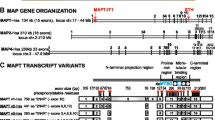Abstract.
Microtubule associated protein tau (MAPT) encodes the microtubule associated protein tau, the primary component of neurofibrillary tangles found in Alzheimer's disease and other neurodegenerative disorders. Mutations in the coding and intronic sequences of MAPT cause autosomal dominant frontotemporal dementia (FTDP-17). MAPT is also a candidate gene for progressive supranuclear palsy and hereditary dysphagic dementia. A human PAC (201 kb) and a mouse BAC (161 kb) containing the entire MAPT and Mtapt genes, respectively, were identified and sequenced. Comparative DNA sequence analysis revealed over 100 conserved non-repeat potential cis-acting regulatory sequences in or close to MAPT. Those islands with greater than 67% nucleotide identity range in size from 20 to greater than 1700 nucleotides. Over 90 single nucleotide polymorphisms were identified in MAPT that are candidate susceptibility alleles for neurodegenerative disease. The 5′ and 3′ flanking genes for MAPT are the corticotrophin-releasing factor receptor (CRFR) gene and KIAA1267, a gene of unknown function expressed in brain.
Similar content being viewed by others
Author information
Authors and Affiliations
Additional information
Received: 1 April 2001 / Accepted: 20 April 2001
Rights and permissions
About this article
Cite this article
Poorkaj, P., Kas, A., D'Souza, I. et al. A genomic sequence analysis of the mouse and human microtubule-associated protein tau. Mammalian Genome 12, 700–712 (2001). https://doi.org/10.1007/s00335-001-2044-8
Published:
Issue Date:
DOI: https://doi.org/10.1007/s00335-001-2044-8




